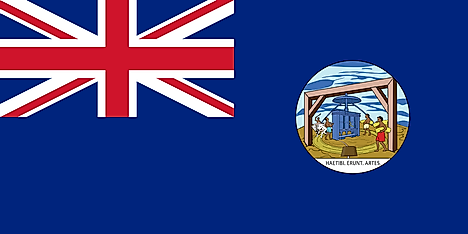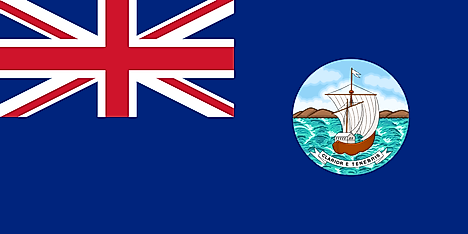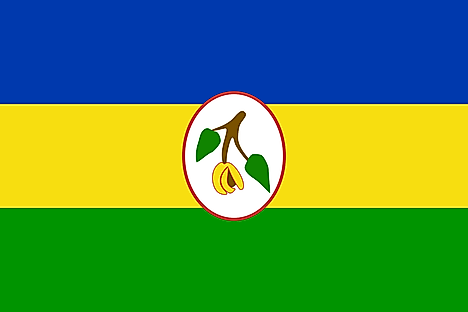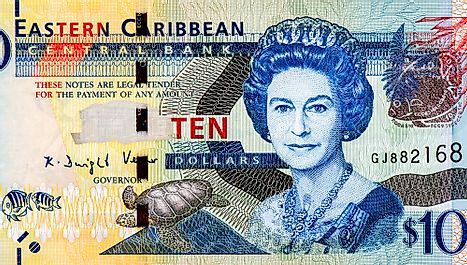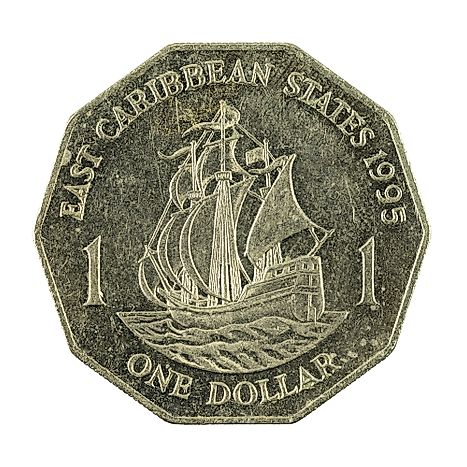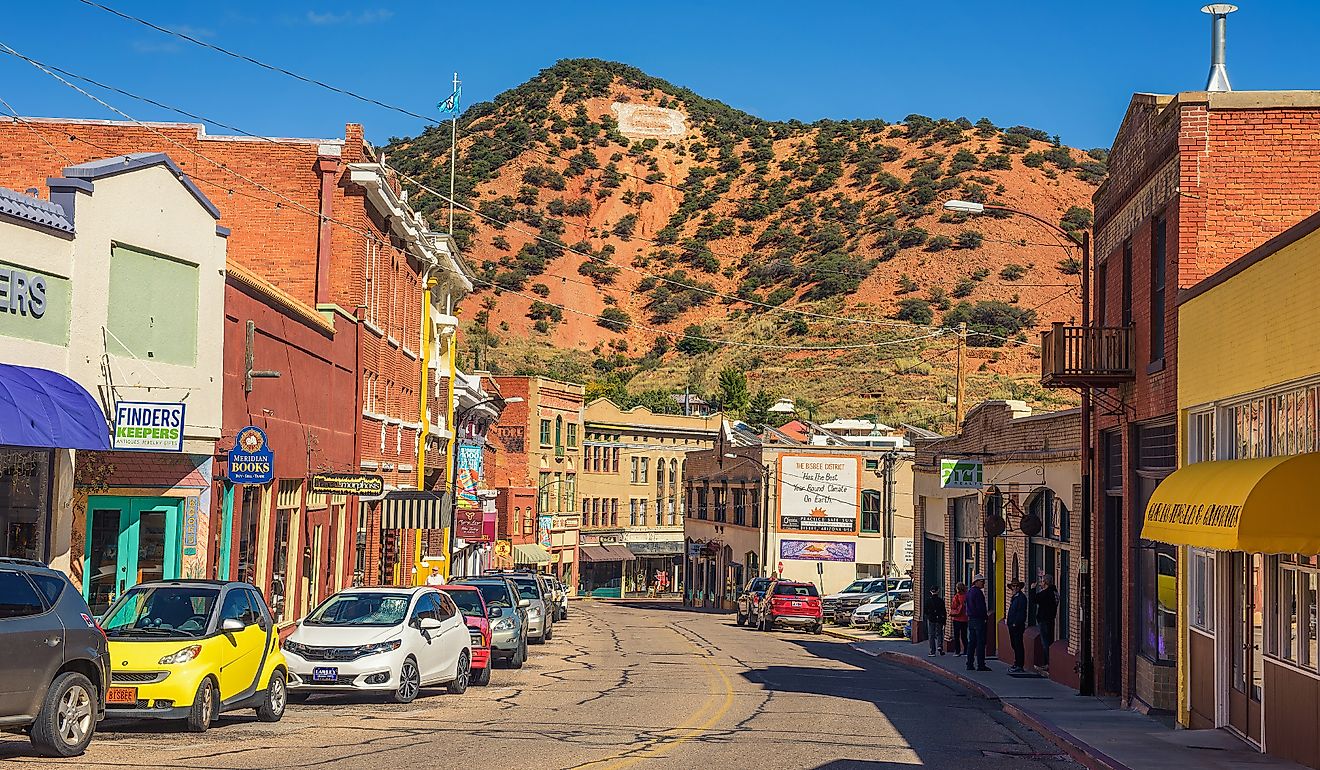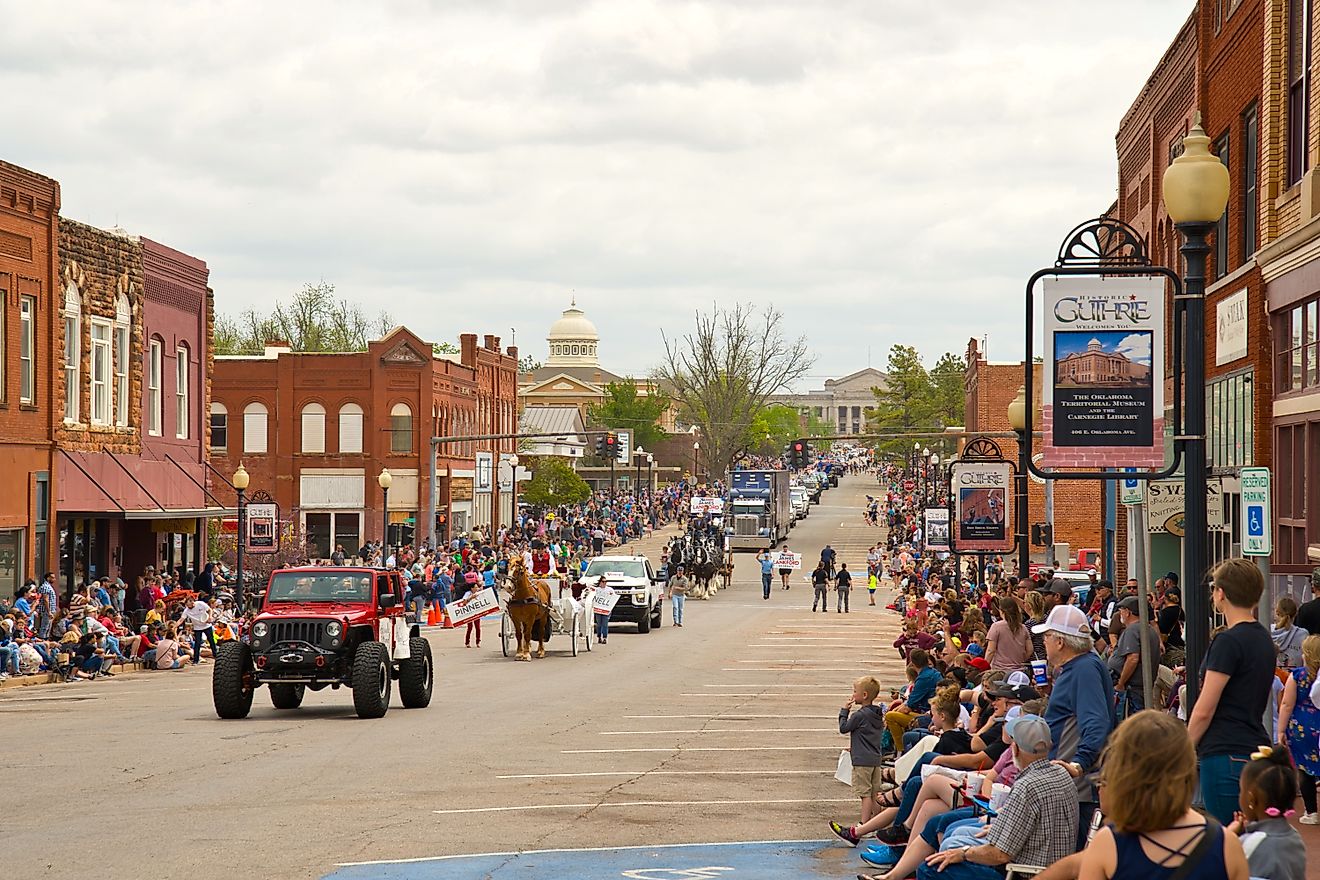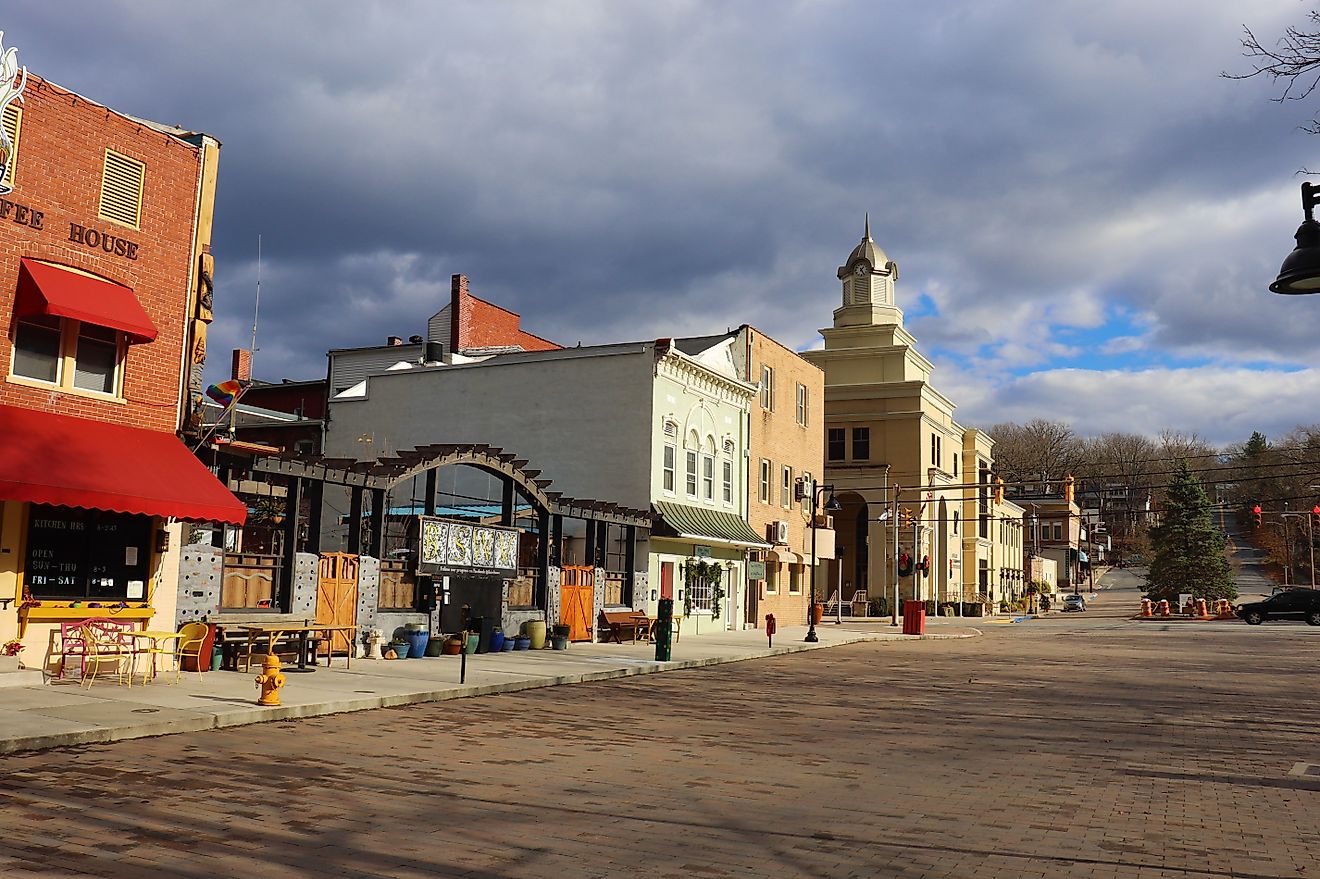Flags, Symbols, & Currencies of Grenada
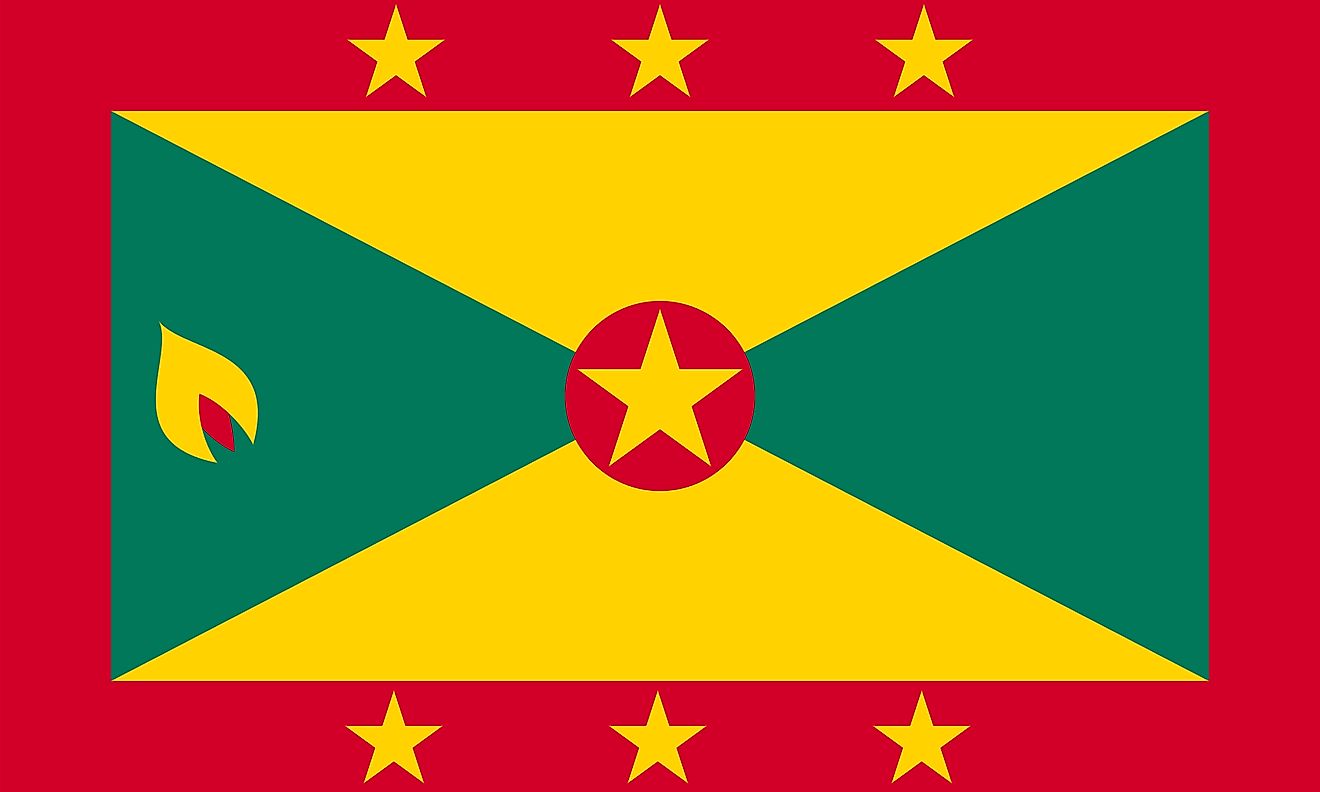
The Flag of Grenada was adopted on February 7, 1974, after the country gained its independence from the United Kingdom, and replaced an older flag that had been used in Grenada since 1967. Antony C. George, a renowned Grenadian artist, is credited with the designing of the flag. The flag is recognized as a sacred and official emblem of Grenada, with the country having official etiquette followed during its hoisting and lowering.
The flag has a rectangular design with the width-length proportion of 3:5. A rectangle divided diagonally into yellow triangles (top and bottom) and green triangles (hoist side and outer side), with a red border around the flag; there are seven yellow, five-pointed stars with three centered in the top red border, three centered in the bottom red border, and one on a red disk superimposed at the center of the flag. There is also a symbolic nutmeg pod on the hoist-side triangle (Grenada is a leading nutmeg producer).
The six small yellow stars spread along the flag’s red margin represent the six parishes that makeup Grenada. The seventh largest star on the flag’s center represents the nation’s capital city, Saint George, but is also believed to represent Carriacou and Petite Martinique, two sister islands of the nation. However, the two conflicting representations of the middle star have been polarizing topics in the country’s politics, with some dismissing the sister-islands representation because a prominent politician, Herbert Augustus Blaize, hails from one of the islands. Another controversial angle states that the stars were based on the Grenada United Labor Party’s official emblem, the star. To remedy the confusion, some individuals have proposed the addition of another yellow star to the six stars on the red margin to represent Carriacou and Petite Martinique, to leave the large middle star to represent unity and harmony in Grenada. The nutmeg seen on the hoist of the Flag of Grenada represents the country’s top agricultural export commodity, the nutmeg, with Grenada being among the largest global producers of the commodity. The symbol is also inspired by Grenada’s history as the nation was traditionally referred to as the “Isle of Spice.”
The colors featured on the flag of Grenada are characteristic of “Pan-Africanism” colors. Therefore some scholars feel that the choice of these colors was in honor of the African heritage of many of Grenada’s inhabitants. The red color represents the courageous and tenacious spirit in Grenadians, and could also represent the country’s undying aspirations. The red border stands for the preservation of unity and harmony among all the country’s inhabitants. Green represents the abundance of greenery in the form of vegetation in the country. The color can also be seen as representing the agriculture and fertility of the soil in the country. Yellow represents the warm weather experienced in the country throughout the year, as well as the warmth of the Grenadians.
Symbols of Grenada
Coat of Arms of Granada
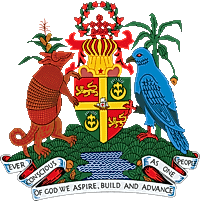
The Coat of Arms of Grenada is a shield divided into four parts by a golden cross. In the center of this cross is the Santa Maria, Columbus' ship. A British lion on a red field is shown in the upper left and lower right sections of the shield, with a golden crescent moon out of which a lily grows in the upper right and lower left sections. Above the shield there is a golden crown, topped with a garland of Bougainvillea branches. Within the garland are seven red roses, which stand for the seven communities of Grenada. Holding the sign are an armadillo in front of a corn stalk; on the other side a Grenada Dove in front of a banana plant. The base represents grassland mountains and Grenada's Grand Etang Lake. A ribbon displays the national motto: "Ever conscious of God we aspire, build and advance as one people."
National Anthem
- Anthem Title: Hail Grenada
- Music composer: Louis Arnold Masanto
- Lyricist: Irva Merle Baptiste-Blackett
- Date of Adoption: 1974
The national anthem of Grenada is "Heil Grenada." Irva Merle Baptiste-Blackett wrote the original lyrics and Louis Arnold Masanto composed the music. Hail Grenada replaced the Grenada National State Anthem adopted in 1967.
Hail Grenada
Hail! Grenada, land of ours,
We pledge ourselves to thee,
Heads, hearts and hands in unity
To reach our destiny.
Ever conscious of God,
Being proud of our heritage,
May we with faith and courage
Aspire, build, advance
As one people, one family.
God bless our nation.
The Currency of Grenada is the Eastern Caribbean dollar
Grenada is a country in the Caribbean nicknamed the “Spice Isle.” The official currency used in Grenada is the Eastern Caribbean dollar, which is coded as XCD. The currency is written as EC$ to avoid confusion with other dollar currencies. The currency is used by all Organisation of Eastern Caribbean States (OECS) member states. Apart from Grenada, the other member states are Saint Lucia, Saint Kitts and Nevis, Montserrat, Anguilla, Dominica, Antigua and Barbuda, and St. Vincent and the Grenadines. In fact, by 2014, over 613,000 people who inhabit these nations used the EC$ currency.
Coins
The ECCA issued the first EC$ coins from 1981 after the currency switch from BWI dollars to EC$. The denominations introduced were 1, 2, 5, 10, and 25 cents, as well as 1 dollar. They were struck in aluminium and had a scalloped shape. The shape of the coins was later changed to decagonal, and then to a round shape. The coins used currently are round in shape, and are available in the same denominations listed above.
Banknotes
The first banknotes to be issued by the ECCA were printed in 1965 and came in denominations of 1, 5, 20 and 100 dollars. They all had the portrait of Queen Elizabeth II. In 2012, the ECCB introduced banknotes with braille features for the use of visually impaired persons living in the Caribbean states. This additional feature has been added to all denominations except the EC$5. The East Caribbean dollar banknotes that exist today are in denominations of 5, 10, 20, 50 and 100 dollars. The portrait of Queen Elizabeth II is still found on the obverse of the banknotes. The reverse side features images such as Brimstone Hill Fortress National Park, Government House, Tropical fish, Sir William Arthur Lewis, and a map of the OECS.
History of Currency Use In Grenada
Initially, the currency used by the OECS was the “silver pieces of eight royals” coins. However, in 1840, Grenada adopted its first currency, the British pound sterling. The pound was used alongside the eight royals coin until it was demonetized in 1873 following the world silver crisis. In 1949, the British government introduced the use of British West Indies (BWI) dollar. The pound sterling was converted to BWI dollars at a fixed rate of 1 pound sterling for every 4.80 BWI dollars. The East Caribbean dollar came into existence in 1965, and replaced the British West Indies (BWI) dollar, which was being used by the OECS at the time. At the time, the Eastern Caribbean Currency Authority (ECCA) was responsible for the issuance of the EC$. However, currently the Eastern Caribbean Central Bank (ECCB) issues the EC$. The EC$ has been used by Grenada from 1965 to date.
